





|
NAME |
C16 - C116 |
|
MANUFACTURER |
Commodore |
|
TYPE |
Home Computer |
|
ORIGIN |
U.S.A. |
|
YEAR |
1984 |
|
BUILT IN LANGUAGE |
Commodore BASIC 3.5 - Built-in machine code monitor (12 commands) |
|
KEYBOARD |
66 keys with 4 function keys and 4 cursor keys |
|
CPU |
7501 |
|
SPEED |
0.89 MHz or 1.76 MHz |
|
COPROCESSOR |
VIC-II (video & sound) |
|
RAM |
16 KB (12 KB free for user) |
|
ROM |
32 KB |
|
TEXT MODES |
40 chars. x 25 lines |
|
GRAPHIC MODES |
320 x 200 / 320 x 160 (with 5 lines of text) / 160 x 200 / 160 x 160 (with 5 lines of text) |
|
COLORS |
121 (15 colors x 8 luminance + black) |
|
SOUND |
two channels; 4 octaves + white noise |
|
SIZE / WEIGHT |
40.7 (W) x 20.4 (D) x 7.7 (H) cm |
|
I/O PORTS |
Tape, Cartridge, Joystick (2), serial, Composite Video, TV |
|
BUILT IN MEDIA |
Cassette unit. Provision for 5.25 |
|
OS |
ROM Based |
|
PRICE |
Ј129.99 (C16 starter pack) |
|
Commodore C-16
|
|
Commodore C-16 |
|
chip named TED. With 16 colors, and 16 shades of colors, it had an amazing 128 colors available.
But it had no hardware sprites like the ones on the VIC II chip, so animated games and collision detection
were very hard to do.
|
